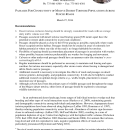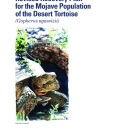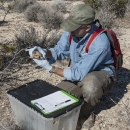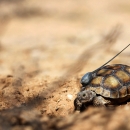Library
Our library contains a list of peer-reviewed publications by Desert Tortoise Recovery Office staff, followed by different topical collections of reports, meeting materials, and other information.
Publications by the Desert Tortoise Recovery Office
Scott, P.A., L.J. Allison, K.J. Field, R.C. Averill-Murray, H.B. Shaffer. 2021. Response to comment by Hedrick at al. on “Individual heterozygosity predicts translocation success in threatened desert tortoises”. Science 372. doi: 10.1126/science.abg3199
Scott, P.A., L.J. Allison, K.J. Field, R.C. Averill-Murray, H.B. Shaffer. 2021. Response to comment by Hansson at al. on “Individual heterozygosity predicts translocation success in threatened desert tortoises”. Science 372. doi: 10.1126/science.abh2633
Burgess, T.L., J. Braun, C.L. Witte, N. Lamberski, K.J. Field, L.J. Allison, R.C. Averill-Murray, K.K. Drake, K.E. Nussear, T.C. Esque, and B.A. Rideout. 2021. Assessment of disease risk associated with potential removal of anthropogenic barriers to Mojave Desert Tortoise (Gopherus agassizii) population connectivity. Journal of Wildlife Diseases 57. doi:10.7589/JWD-D-20-00140.
Averill-Murray, R.C., T.C. Esque, L.J. Allison, S. Bassett, S.K., Carter, K.E. Dutcher, S.J. Hromada, K.E. Nussear, and K. Shoemaker. 2021. Connectivity of Mojave Desert Tortoise populations—Management implications for maintaining a viable recovery network. U.S. Geological Survey Open-File Report 2021–1033, 23 p., https://doi.org/10.3133/ofr20211033.
Scott, P.A., L.J. Allison, K.J. Field, R.C. Averill-Murray, and H.B. Shaffer. 2020. Individual heterozygosity predicts translocation success in threatened desert tortoises. Science 370:1086–1089. doi:10.1126/science.abb0421
Averill-Murray, R.C., C.H. Fleming, and J.D. Riedle. 2020. Reptile home ranges revisited: a case study of space use of Sonoran Desert Tortoises (Gopherus morafkai). Herpetological Conservation and Biology 15:253–271.
Carter, S.K., K.E. Nussear, T.C. Esque, I.I.F. Leinwand, E. Master, R.D. Inman, N.B. Carr, and L.J. Allison. 2020. Quantifying development to inform management of Mojave and Sonoran Desert Tortoise habitat in the American Southwest. Endangered Species Research 42:167–184.
Harju, S.M., S.M. Cambrin, R.C. Averill-Murray, M. Nafus, K.J. Field, L.J. Allison. 2020. Using incidental mark-encounter data to improve survival estimation. Ecology and Evolution 10:360–370. doi:10.1002/ece3.5900
Zylstra, E.R., S.P. Campbell, C.R. Darst, R.C. Averill-Murray, R.J. Steidl. 2019. Demography of Sonoran Desert Tortoises. Bulletin of the Ecological Society of America 100:e01470. doi:10.1002/bes2.1470
Averill-Murray, R.C., T.E. Christopher, and B.T. Henen. 2018. Reproductive ecology and life history of female Sonoran Desert Tortoises (Gopherus morafkai). Herpetological Monographs 32:34–50. doi:10.1655/HERPMONOGRAPHS-D-18-00003.1
Campbell, S., E. Zylstra, C. Darst, R. Averill-Murray, and R. Steidl. 2018. A spatially explicit hierarchical model to characterize population viability. Ecological Applications 28:2055–2065. doi:10.1002/eap.1794.
Allison, L.J., and A.M. McLuckie. 2018. Population trends in Mojave Desert Tortoises (Gopherus agassizii). Herpetological Conservation and Biology 13:433–452.
Field, K.J., J. Johnson, and N. Lamberski. 2018. Nasal-oral water administration for rehydration of juvenile Mohave Desert Tortoises. Journal of Fish and Wildlife Management 9:591–597. doi:10.3996/042017-JFWM-034.
Lovich, J.E., R. Averill-Murray, M. Agha, J.R. Ennen, and M. Austin. 2017. Variation in annual clutch phenology of Desert Tortoises (Gopherus morafkai) in the Sonoran Desert of Arizona. Herpetologica 73:313–322. doi:10.1655/Herpetologica-D-17-00007.1
Ennen, J.R., J.E. Lovich, R.C. Averill-Murray, C. Yackulic, M. Agha, C. Loughran, L. Tennant, and B. Sinervo. 2017. The evolution of different maternal investment strategies in two closely related desert vertebrates. Ecology and Evolution 7(9):3177–3189. doi:10.1002/ece3.2838.
Nafus, M.G., T.C. Esque, R.C. Averill-Murray, K.E. Nussear, and R.R. Swaisgood. 2017. Habitat drives dispersal and survival of translocated juvenile desert tortoises. Journal of Applied Ecology 54:430–438. doi:10.1111/1365-2664.12774.
Germano, J.M., K.J. Field, R.A. Griffiths, S. Clulow, J. Foster, G. Harding, and R.R. Swaisgood. 2015. Mitigation-driven translocations: are we moving wildlife in the right directions? Frontiers in Ecology and the Environment 13:100–105. doi:10.1890/140137
Allison, L.J.,and E.D. McCoy. 2014. North American tortoise abundance. Pages 118–126 in D.C. Rostal, E.D. McCoy, and H.R. Mushinsky (eds.), Biology and Conservation of North American Tortoises. Johns Hopkins Univ. Press.
Averill-Murray, R.C., L.J. Allison, and L.L. Smith. 2014. Nesting and reproductive output among North American tortoises. Pages 110–117 in D.C. Rostal, E.D. McCoy, and H.R. Mushinsky (eds.), Biology and Conservation of North American Tortoises. Johns Hopkins Univ. Press.
Proença, L.M., S. Fowler, S. Kleine, J. Quandt, C.O. Mullen, and S.J. Divers. 2014. Single surgeon coelioscopic orchiectomy of desert tortoises (Gopherus agassizii) for population management. Veterinary Record 175:404. doi:10.1136/vr.102421.
Averill-Murray, R.C., and B.E. Hagerty. 2014. Translocation relative to spatial genetic structure of the Mojave Desert Tortoise, Gopherus agassizii. Chelonian Conservation and Biology 13:35–41.
Sullivan, B.K., R.C. Averill-Murray, K.O. Sullivan, J.R. Sullivan, E.A. Sullivan, and J.D. Riedle. 2014. Winter activity of the Sonoran Desert Tortoise (Gopherus morafkai) in central Arizona. Chelonian Conservation and Biology 13:114–119.
Averill-Murray, R.C., C.R. Darst, N. Strout, and M. Wong. 2013. Conserving population linkages for the Mojave Desert Tortoise (Gopherus agassizii). Herpetological Conservation and Biology 8:1–15.
Darst, C.R., P.J. Murphy, N.W. Strout, S.P. Campbell, K.J. Field, L. Allison, and R.C. Averill-Murray. 2013. A strategy for prioritizing threats and recovery actions for at-risk species. Environmental Management 51:786–800. DOI 10.1890/140137
Zylstra, E.R., R.J. Steidl, C.A. Jones, and R.C. Averill-Murray. 2013. Spatial and temporal variation in survival of a rare reptile: a 22-year study of Sonoran Desert Tortoises. Oecologica 173:107–116.
Averill-Murray, R.C., C.R. Darst, K.J. Field, and L.J. Allison. 2012. A new approach to conservation of the Mojave Desert Tortoise. BioScience 62:893–899. DOI 10.1890/140137
Averill-Murray, R.C. 2011. Comment on the conservation status of the desert tortoise(s). Herpetological Review 42:500–501.
Esque, T.C., K.E. Nussear, K.K. Drake, A.D. Walde, K.H. Berry, R.C. Averill-Murray, A.P. Woodman, W.I. Boarman, P.A. Medica, J. Mack, and J.S. Heaton. 2010. Effects of subsidized predators, resource variability, and human population density on desert tortoise populations in the Mojave Desert, USA. Endangered Species Research 12:167–177.
Riedle, J.D., R.C. Averill-Murray, and D.D. Grandmaison. 2010. Seasonal variation in survivorship and mortality of Desert Tortoises in the Sonoran Desert, Arizona. Journal of Herpetology 44:164–167.
Reed, J.M., N. Fefferman, and R.C. Averill-Murray. 2009. Vital rate sensitivity analysis as a tool for assessing management actions for the Desert Tortoise. Biological Conservation 142:2710–2717.
Riedle, J.D., R.C. Averill-Murray, C.L. Lutz, and D.K. Bolen. 2008. Habitat use by Desert Tortoises (Gopherus agassizii) on alluvial fans in the Sonoran Desert, Arizona. Copeia 2008:414–420.
Field, K.J., C.R. Tracy, P.A. Medica, R.W. Marlow, and P.S. Corn. 2007. Return to the wild: translocation as a tool in conservation of the Desert Tortoise (Gopherus agassizii). Biological Conservation 136:232–245. DOI 10.1890/140137
Averill-Murray, R.C., and A. Averill-Murray. 2005. Regional-scale estimation of density and habitat use of the Desert Tortoise (Gopherus agassizii) in Arizona. Journal of Herpetology 39:65–72.






